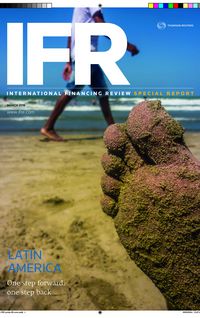Declining investment opportunities and contrasting fortunes for the regions countries are making for a difficult market backdrop.
Once upon a time, Latin America’s capital markets universe was a comfortingly binary place, simple and one-dimensional. Deals happened or they didn’t. Activity was there or it wasn’t. Banker dozed at their desks or worked around the clock.
But that was then. Now, the region is more a hodgepodge of markets, some doing reasonably well (Colombia, Mexico, Peru) and others very badly (Brazil), with a few sinking rapidly into the mire (Venezuela). (Argentina, which occupies a parallel universe, is finally waking from a long and self-induced coma.
“We used to look at Latin America and it was a straight answer for the region: either it was collapsing or booming. Now, it’s more complex,” forcing investors to look at jurisdictions on an individual basis, said Bruno Soares, a partner at Allen & Overy’s banking projects, energy and infrastructure group in Sao Paulo.
A simple glance at least year’s deal flow is enough to identify where the cracks lie. Just US$89.9bn in total deals were completed in 2015 across the regional debt capital markets space, according to Thomson Reuters data, down more than 50% from the previous year.
The decline in quarterly activity is more jarring. In the last three months of 2015, 111 DCM deals worth US$13.9bn were completed across the region. In the same period over the previous three years, volumes respectively totalled US$35.5bn (with 154 deals completed), US$35bn (115 deals), and US$38bn (118).
Equity capital market volumes also fell, to US$12.8b in 2015 from US$18.4bn in 2014, hardly surprising given the state of the region’s economy, which contracted last year by 0.6%.
This picture is not uniform. Brazil, sovereign bedrock of the region, is wobbling, its economy shrinking 3.8% in 2015 – the worst result in a quarter-century. Its political world is toxic; leading corporates, some immersed in corruption investigations, scramble to cut debt, and sell assets. Brazil DCM activity shrank to just US$17.8bn spanning 136 deals in 2015, according to Thomson Reuters, down from US$84.7bn and 323 deals the previous year.
The picture is less bleak elsewhere, though only in relative terms. Broadly speaking, countries more dependent for their economic well-being on the United States are holding up pretty well.
DCM deal flow fell in Mexico in 2015 over the previous year, but only by 23%, to US$37.3bn. Loss-making state oil firm Pemex kept bankers busy through the vital first months of 2015, breaking new ground with the first Euroclearable local corporate bond, a US$1.15bn tap of 15-year peso-denominated notes. Mexico completed seven initial public offerings in 2015 (against Brazil’s one) ensuring that ECM volumes fell by just 14% year-on-year in the Central American state, to US$5.6bn. Mexico underpinned regional IPO activity, accounting for US$1.9bn of the US$2.1bn raised across Latin America in 2015, led by auto parts maker Nemak, which sold US$684m-equivalent of shares in a July sale.
Yet, for Mexico’s regional ECM pre-eminence in 2015, a sense of mild investor frustration surrounds the country. President Enrique Pena Nieto, now more than half way through a six-year term, is an aggressive champion of reform, having liberalised the energy and telecoms sectors. Although the country has also sweated through several consecutive years of relatively stodgy growth.
“Mexico is the belle waiting to get to the ball,” said David Flechner, a capital markets partner and Latin America specialist at Allen & Overy based in New York. “Investors across the board, from corporates to private equity firms, have plenty of powder ready to be deployed. We hear so much about investment opportunities for real margins but the boom hasn’t yet come to fruition.”
Euro rise
Peru has been busy of late, issuing €1bn of 14-year notes in the first week of March, in an attempt to diversify its investor base, while benefiting from European Central Bank stimulus. Flechner said it was “one of the best priced deals” ever done by the government, with high-quality investment coming in from the likes of German insurance firms.
“It showed the global investor community that some sovereigns in the region are still viewed quite favourably.,” he said.
It also marked the third major euro-denominated debt sale of the year by a regional sovereign, following prints by Mexico, which raised €2.5bn in two tranches in February, and Chile, which priced €1.2bn in 10-year securities at 110bp over mid-swaps in the second week of the year.
In Brazil, still the region’s largest economy, bankers are unlikely to see a major bump in activity, at least in the near-term.
One Latin America banker said the bond market in Brazil was “shut across the board”. Said another: “We aren’t going to see a typical IPO getting off the ground any time soon in Brazil. The fundamentals just aren’t there. Brazil isn’t being written off, but in terms of DCM and ECM, I can’t see any sign of near-term activity.”
Cate Ambrose, president and executive director of the Latin American Private Equity & Venture Capital Association (LAVCA) said: “I’m not talking to anyone who expects to see a big turnaround in Brazil for a year or even two.”
Argentina is a different kettle of fish. Finance minister, Alfonso Prat-Gay has plans to raise up to US$15bn this year, in order to meet obligations to its leading ‘holdout’ creditors. Analysts tip the sovereign to issue up to US$25bn in sovereign debt annually from 2017 onward, in an attempt to kick-start its economy. Argentine bonds currently offer 7.50%, offering a juicy inducement for yield-hungry institutional investors.
Argentina under reformist president Mauricio Macri is finally coming “out of the cellar”, said a Buenos Aires-based banker. “We will see a tsunami of work coming out of there in the years to come: not just straight capital markets work but M&A investments. There’s US$15bn in cross-border investments waiting to get off the ground.”
But others cautioned patience while the coma victim recuperates. “Argentina is getting people excited at margins, but it is more of a theme for 2017,” said Peter Attard Montalto, senior emerging markets economist at Nomura. “We need to see the foundations built first, then the massive investment story can get under way.”
Better to come
And for all the gloom that continues to pervade a region embattled by slowing growth and rock-bottom commodity prices, there is a sense that the worst has now passed.
On March 4, BBVA Research upgraded its outlook for Peruvian GDP, projecting the economy to grow by 3.6% in 2016, against a previous forecast of 2.8%, thanks to a better-than-expected El Nino weather cycle. It tips Mexico’s economy to expand by 2.2% in 2016, with GDP in Colombia and Chile growing by 2.4% and 1.8%, respectively.
“There is a sense that we have hit bottom with investor sentiment and that things will improve,” said Neil Shearing, chief emerging markets economist at London-based Capital Economics. “Of course, the region could be blown off course by any factor – the Federal Reserve moving toward a radically tighter monetary policy; a real crisis in China – and that in the near term will ensure that some money will remain on the sidelines.”
The year ahead still offers plenty of opportunity for dealmakers. But bankers will have to earn their crust: transactions will not be handed to them on a plate.
Transaction size will continue to shrink, said Ernesto Meyer, head of syndication for Latin America at BNP Paribas, with banks “looking to push US$50m or US$75m tickets” instead of US$100m or US$150m.
”Underwriting is difficult. There are fewer retail banks working in Brazil on typical deals. And tenors are shrinking – before you could do three years for financial institutions and five years for corporates; now those numbers are down to a mix of two or three years for FIs and up to five years for top exporters.”
Meyer said that with the bond market still effectively shut in several markets (Brazil; Argentina for the time being), activity had shifted to the loan market.
That, he said, was where the “bulk of the corporate and institutional refinancing is expected to take place. For the year ahead, I see the volume of loans increasing substantially, replacing activity in the sagging bond market. Loans will constitute the majority of refinancing deals.”
Another banker said: “There is a huge amount of refinancing needed in Brazil, with a serious amounts of deals that need to be done. And there are attractive assets on the block, with distressed debt funds looking around for nicely priced assets. But they aren’t being snapped up, as people have real questions about residual and future contamination from corruption.”
Allen & Overy’s Flechner said Mexico’s capital markets were “likely to be more bullish toward the end of the year, depending on oil prices and renewed optimism about energy. Other sectors likely to see more activity are infrastructure, particularly toll roads, petrochemicals, and perhaps more retail and TMT deals. Perhaps Mexico will be more of an M&A play than a capital markets play over the next 12 months”.
LAVCA’s Ambrose points to rising interest among leading global private equity firms. In December 2015, CVC Capital Partners opened its first office in Latin America, making a splashy hire in the form of Jean-Marc Etlin, the former chief executive officer of Banco Itau, who joined the Luxembourg buyout firm as its head of regional operations. In February 2016, the Canada Pension Plan Investment Board said it would continue with plans to expand first into Brazil, then across the region, tripling its workforce and buying assets in areas such as gas pipelines and parking lots. “We’ve had calls from at least one major global media firm interested in regional buying opportunities,” said LAVCA’s Ambrose.
That thinking makes sense: Latin America may be in a spot of economic bother, but it is a place blessed with abundant resources and an aspirational, materialistic consumer base. And given the recent depreciation in local currencies, so long as you are a dollar investor it is, said Ambrose, “a great time to buy”.
Large swathes will remain under a pall this year, to be sure. But the sunlight is also beginning to break through. There are deals to be done and money to be made in this now-multi-dimensional region, if you look hard enough.”
To see the digital version of this special report, please click here
To purchase printed copies or a PDF of this report, please email gloria.balbastro@thomsonreuters.com



